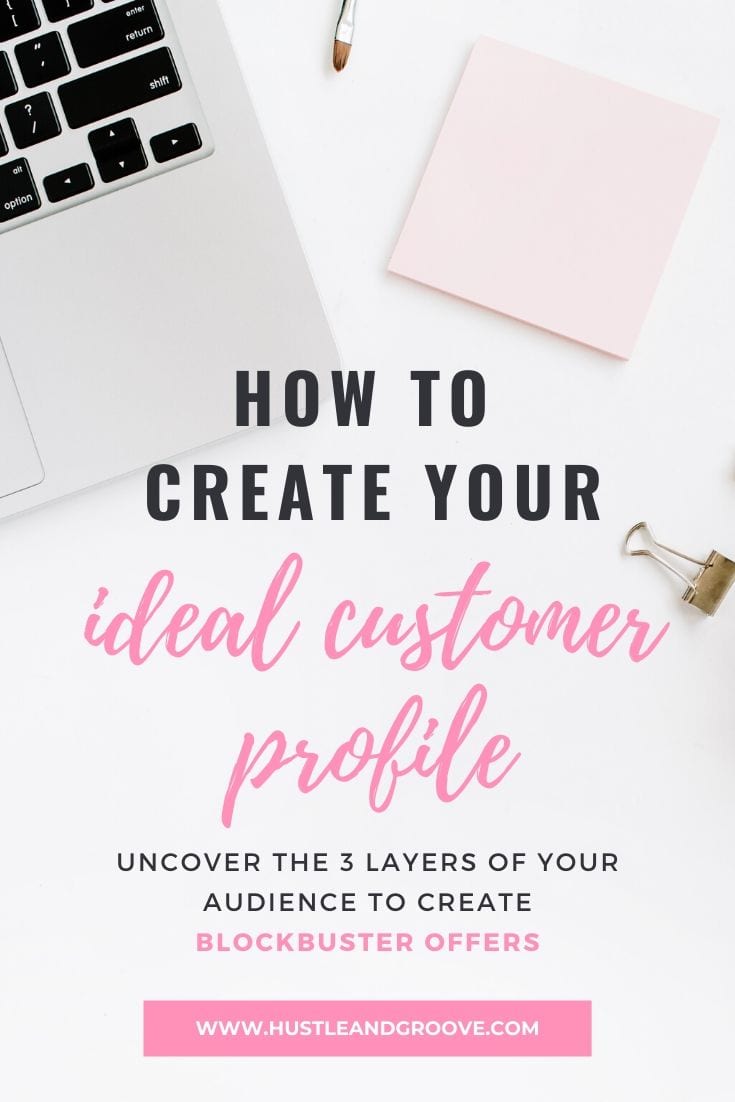I’ve been talking a lot about creating different offers on my live Facebook chats, but let’s take some time to talk about clients and customers. Because if you don't have a customer, you can't make money.
I want you to really think about what your ideal customer looks like because here's the thing… you really do get to decide who you work with. What type of person do you want to work with, and who's your ideal customer? Like what does that look like for you?
When it comes to your ideal customer, this is more the problem that they are facing that you can help them with; whereas the type of person you might want to work with (particularly if you're doing coaching) is more focused on their characteristics and personality.
This can be a little bit confusing to fully get (I know it was for me), so let me break down the differences.
Figuring Out Your Ideal Customer Profiles
Finding Your Ideal Customer: Who do you want to work with?
If you're offering any type of one-on-one coaching or group coaching program, you actually get to decide who you want to work with.
- You have an overall target audience. That includes everyone that was attracted to you and got on your list.
- Next, you identify your ideal target customer, the person who is struggling with the thing that you're coaching on. They are within that target audience.
- Then take that a level deeper and identify the type of person you want to work with. This is different from them just being your customer. It’s a subset of your ideal customer group.
My target audience is women who want the freedom of working on their own terms. It could be a freelancer, a coach, an energy healer, a graphic designer, or a virtual assistant. Someone who identifies as a creative entrepreneur.
My ideal target customer is a subset of that audience and who that is depends on the offer I’m creating.
For example, for the Micro Offers Workshop that I offered in May 2020, my ideal target customer was someone who:
- wants to start an online business,
- is struggling with how to do that,
- wants to either be a coach or course creator,
- wants to teach or share knowledge,
- and is struggling to figure out how to actually do that (bootcamp, workshop, or mini course)
Do you see the difference? My ideal target customer is a subset of my target audience.
Those bullet points are the things that I'm teaching in that offer, and that's the type of person that I know I can help. So that's my ideal target customer for that specific workshop.
What type of person do you like working with?
However, the type of person that I personally want to work with is even more specific. The type of person that I personally love working with is someone with a positive outlook, that is action-orientated, that only ever uses positive words, and doesn't have a negative view on the world.
For example, if I was working with you inside a group coaching program or a one-on-one coaching environment, and I asked you to identify what your next step was going to be and report back on what tweaks you're going to make but you don't do it, then you're not the type of person that I want to work with or that I can truly help.
I can only help people who are action orientated.
If I'm spending my time coaching someone, I want their energy to match my energy. And that has nothing to do with being introverted or extroverted.
If someone is excited about starting an online business, is excited to learn, if they're a sponge for information and want to be there… That is definitely the type of person that I want to work with.
You can think about it this way… If you're spending time with someone, what characteristics or traits would you want them to have?
The type of person that I want to be working with day in and day out is essentially a friend.
Intentionally Attract Your Ideal Customer
Intentionally attract the type of person you want to work with, but also understand who your ideal target customer is for each offer.
Each offer you create should have a specific customer in mind versus trying to do something that serves everyone on your list.
And nine times out of ten, you are part of your target audience, right?
We tend to teach the things we have experienced because we can easily talk about what it took to overcome that struggle. We've experienced it first hand and therefore know what it takes to overcome it. So think about it from that perspective as a starting point.
If you still have no idea who your ideal target customer is, I will tell you this: your ideal target audience starts with you. Why did you start your online business? Or why are you looking to start an online business? Where do you fit in when it comes to your target customer?
When I first started Hustle and Groove, I was specifically helping people start a side hustle and start an online business. I could do that because I was teaching what I myself needed to know two or three years earlier. I knew what the pitfalls were. It was easy to remember all the things that I had struggled with. I could help people avoid those pitfalls.
You’ve got two ways that you can approach this.
- You can either create a target customer profile for each offer you create, or
- You can just solely focus on the type of person you want to work with.
They are two different things, and depending on what you are doing will really depend on which one is a better fit for you.
Why Clarity on Ideal Customer is Important
I made a huge mistake back in 2016-2017. During those years I went down the path of creating without:
- Making sure I had an audience that wanted to buy what I was creating, and
- Verifying that what I was creating was actually meeting their needs.
I created 20+ courses and put in over 200+ hours of work before I even thought about selling or who my target audience was. I was purely in creation mode because I love creating. I'm a creative entrepreneur. The creating piece for me is addictive.
But I’ve since learned that if I want a business that's going to make money, I have to be smart with my time.
I have to be strategic and find a balance between creating what I love and creating what my target customer wants and needs.
So that's why I no longer create offers ahead of time. Unless it's something I've delivered before, I literally create as I go. Generally 24 hours out is my creation process and what’s comfortable and easy for me.

Filtering Coaching Clients
In the past, I have taken on a few clients in a one-on-one coaching situation who were NOT the right fit. I took them on at the time because I wasn't clear on the type of person I wanted to work with and I thought I had to take on anyone that would pay me…
One-on-one coaching with a client you don't gel with is the worst situation to be in. When you discover that the person isn't a good fit, you will resent working with them.
You can tell a lot about someone and if they’re a good fit just through an email conversation. If someone's reached out to me and is inquiring about one-on-one coaching, then I will likely have an email conversation back and forth with them.
If they pass my spidey-filters at that point, I'll invite them to a 15-minute call. But this is only for one-on-one coaching. It's not for group coaching or my other training.
Having a 15-minute conversation with someone before any money is exchanged is your best way to figure that piece out. It’s nothing formal, just a conversation like you're meeting someone for the first time. It’s the best way to really figure out if they're going to be a good fit for you.
You can't help everyone…
You might think you can help every person in the world, but they aren’t going to learn from you and take in what you're saying if the two of you don't gel.
It’s the same when someone joins my email list. In one of the very first emails that they get I ask, “are we gonna gel?” And I list all the things that I do, who I can help, and what I don't believe in. At that time I also let them know that if none of this gels with them, they can unsubscribe.
I would rather someone leave at that point than stay in my world and infect it with negativity or nastiness. I do not tolerate either of those things. Again, that’s a conscious choice I’ve made in what I want my business to look and feel like. I get to decide that and you do too.
What happens during a 15 minute call?
On a 15 minute call for a one-on-one coaching session, I ask a lot of questions. I want to learn about the person and what it is they’re trying to achieve, and I just let them talk. I can get a feel for what someone is like just from having that conversation. If, at the end, I don't feel like we're a good fit, I'm going to say something along the lines of,
“Hey, thanks so much for chatting. I'm going to get back to you with some more details via email. It was so great to meet you.”
I'm not going to discard them right there and then ‘cause that's not my style. That's just what feels good to me personally, but you decide what it looks like for you. I would then follow up via email and just say,
“Hey, it was so great to meet you, but I don't believe that I can help you. Here is someone else that I recommend.”
I never ever want to leave someone hanging.
This is another reason why networking is so important. When you connect with other people in your space, you can refer them to others that might be a better fit.
However, I would never ever refer someone who is just plain out nasty. Luckily, I've never had someone like that. I just do not attract those types of people.
If someone ever came through and they truly were nasty, I probably would say something on the call. I've got nothing to lose and I'm certainly not referring someone nasty to someone I respect.
It takes a lot of energy to do one-on-one coaching. If that’s something you're thinking about doing, then you really do need to be clear on the type of person you want to want to work with.
Personalities That Gel Together Work Well Together

Knowing your own personality will help a lot if you plan on coaching people. If you don't know much about your personality strengths, you really need to figure that out because it will help you enjoy your business in the long term.
Some personality profiles to consider:
The Four Tendencies book is really good to have on hand if you’re planning to coach people. When you understand what your tendency is and then have each of your clients take the four tendencies quiz, then you’ll know how to really help them. It's not so much about personality, it's more about personal defaults and how we handle situations where we're asked to do something from an external environment versus what we want to do internally.
I'm an Upholder, which is someone who balances both internal and external expectations. I’m self-motivated. It also means that I do not sacrifice one for the other. So if I have something internally that I want to do, I will push back on an external and, and vice versa. If an external thing is important to me I will do it as long as it doesn't impact an internal requirement.
Not many people are wired that way–only about 5% of the population (we’re kinda like unicorns??) . So when someone says to me, “Lise I want to do everything that you do,” I'm like, well, you can't unless you are exactly why the same way as I am. This is why it's important that you understand how you tick.
I’m constantly looking to understand myself so that I can make sure that I’m always living from a place of fun and easy. What’s easy and fun for me might not be the same for you, right? So the more that you can arm yourself with knowing how you tick, the better off you're going to be. But also the better off your coaching clients are going to be!
Know who you can help
When it comes to figuring out the type of person that I want to work with, I know that I can 100% help someone who is an Obliger. I can 100% help someone who's a Questioner, but a Rebel and I are probably going to struggle. The Rebel is definitely a unique unicorn, just like an Upholder is! A Rebel is not motivated by internal or external requirements. They’re motivated only by whether they feel like doing something and have the freedom to choose what that looks like. So unless they are 100% committed, we would struggle together.
When I understand the personality type of the person I’m working with, I then know the signs to look for. That's why having The Four Tendencies book is super handy when you’re a coach because it tells you how to work with each individual tendency.
The more that you understand who you are, the more you can understand who you can help, and the more you can understand who is the best fit for you to work with.
But it all starts with understanding who you are, understanding who you want to work with, understanding the offer that you're providing and the customer that you're serving. All of those pieces need to be there for everything to align.
Obviously, you can only get this granular with one-on-one coaching clients. Group coaching is a little different.
Group Coaching
A group coaching situation is a little bit different as you're not having individual conversations. But if someone does something that is out of alignment with the type of person I want to work with (remember, I want to work with positive people), I'm automatically going to message them personally. I give them a warning when they've broken one of the group rules because that group is in my house. It’s where I conduct business and I get to choose what that looks like and feels like.
Pro tip: If you’re creating any type of online group–whether it's on Facebook or LinkedIn–make sure the group rules are extremely clear. Spell out exactly what you do not tolerate and what will happen if rules are broken.
It's the same for any pop-up group that's only available for a short period of time. Regardless if someone has paid money to be in your group, there are still rules for engaging with other people.
One chance is what someone gets in my house. So if a rule is broken, I'll message them and let them know they’re in violation of a particular rule.
Facebook in particular makes this easy. When you mark a comment or a post inside your group and want it either hidden or deleted, it automatically comes up and asks which of these rules has the person broken. Here is a message that you can send to them. I fill in the blank with a brief message and tick the rule that has been broken.
You need to be clear on your rules for both one-on-one coaching and group coaching situations and be willing to enforce them.
If you want to take your online biz to the next level, you owe it to yourself to check out The Digital Business Lab. It's an online community and training hub to easily guide you through starting and growing your online business.
If you have something you want to teach, or if you're a coach and just want to figure out what to offer, then The Digital Business Lab might be exactly what you need.
Inside I cover entrepreneur mindset, workshops and bootcamps, mini courses, and how to create a strategy in your business. You will learn tried and tested methods on how to set up your offers, create them, make decisions about what you need to do, plus how to sell your offers.
And one of the most valuable parts of The Lab membership is the accountability. It's a community in every sense. While you might be in business for yourself you are never by yourself and no question goes unanswered. It's a community that cheers you on to success in every sense. If that kind of knowledge and support is something you could use in your business, go here to learn more.
Action Step:
Identify your 3 layers of customers:
- Target audience
- Ideal target customer
- Ideal type of customer
Who you want to work with? What is their personality type? Does it mesh with your own?
Remember, you get to decide what your business looks like.?
